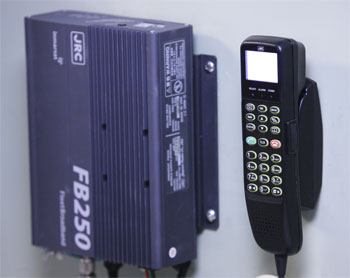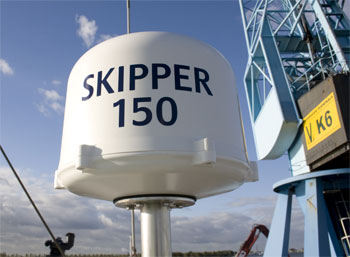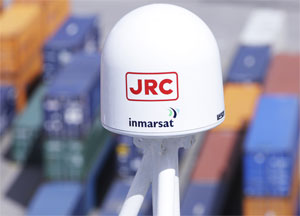A few years ago, the Dutch shipping giant Vroon BV decided to rethink its communications strategy.
The company, which owns 160 ships and employs about 4,000 mariners worldwide, was experiencing problems with its onboard computer networks, including viruses and unapproved changes.
Vroon’s onboard satellite communications systems also needed an upgrade. The company, based in the seaside town of Breskens, used several satellite providers and had different types of terminals installed across its fleet of box ships, tankers, supply vessels, livestock carriers and car carriers. It faced unpredictable and sometimes high satellite data costs.
Based on business trends, Vroon’s managers wanted the bandwidth to allow for better monitoring while at sea and more integration between its ships and the home office. Ensuring bandwidth was available for crew, Internet use during long sea voyages was another priority.
Vroon decided early that its own in-house technicians would not manage the new system.
“As opposed to continue managing it ourselves, we have decided to search the market and to take advantage of proven and tested maritime solutions,” Johan Verhegge, Vroon’s manager of ICT infrastructure, said in a PowerPoint presentation given earlier this year at the Digital Ship Conference in Bergen, Norway.
Deciding which satellite firm to partner with, and what type of system to install on the large and varied fleet, was not as easy.
 |
|
Courtesy Inmarsat |
|
A below-decks unit, handset and cradle, part of an Inmarsat FleetBroadband 150 system. |
Indeed, as demand for more and faster data at sea continues to grow, maritime operators large and small are facing a similar dilemma, said satellite industry consultant Alan Gottlieb, head of Gottlieb International Group, in a phone interview.
Many shippers want to upgrade their aging systems to faster, more advanced technology, but some are waiting until the shipping market picks up, he said. At the same time, more and more companies that got by without satellite terminals until now are giving satellite a fresh look, in part because modern systems offer greater operational efficiencies and costs have fallen sharply.
Nevertheless, trying to sift through competing providers, options, plans and pricing can be daunting. The choices are only expected to grow more difficult with Inmarsat’s planned launch of a next-generation network expected in late 2014 and Iridium’s NEXT network that’s expected to be operational a few years down the road.
“If you think this is complicated (for you), just imagine the poor ship owners,” Gottlieb said.
Inmarsat’s FleetBroadband has been the go-to system for years for satellite voice and data, and the company said it is installed as the primary or backup satellite system on about 40,000 vessels worldwide. Although the company’s L-band service is extremely reliable in bad weather, it doesn’t work in Arctic or Antarctic regions. Pricing and download speeds, which range from 150 to 500 Kbps, depend on the type of package chosen and the amount of bandwidth requested.
Iridium’s OpenPort and Pilot systems, which also operate on an L-band frequency, are equally reliable and offer truly global coverage, including the poles. Like Inmarsat, pricing will vary by how much the operator wants to pay and what type of service they want. However, Iridium’s baseline data download speeds are only about 128 Kbps.
A third option for maritime voice and data is VSAT, which emerged on the maritime market only about five years ago. These systems, which typically operate on a Ku-band frequency, are sold by third-party suppliers such Marlink, Globecomm Systems, KVH Industries and numerous others around the world. Many VSAT systems offer data download speeds of 1 Mbps and up, but the signal is highly susceptible to rain-fade — or interference from heavy rains common when sailing in the tropics.
These third-party suppliers typically buy maritime Ku-band capacity from satellite owners and then manage that capacity among their subscribers. Most suppliers also sell value-added packages that include advanced software, data management and other services.
“With VSAT, they are selling you a system and that system consists of bandwidth, software to manage that bandwidth, software to control usage by the crew, software and hardware to switch between IP solutions on the vessel as needed and software to go in and take a look at what bandwidth you’re getting,” said Gottlieb. “It’s all part of integrating the system to the end user.”
Although VSAT offers data download speeds that were unheard of just a few years ago, the service still can’t match what most people get at home from the cable company.
“What you get at sea for connectivity is about what you got on land 10 years ago,” said Brent Bruun, vice president of the mobile broadband group at KVH Industries, of Middletown, R.I.
 |
|
Courtesy Inmarsat |
|
A Skipper 150 antenna, part of a mounted FleetBroadband 150 terminal made by Inmarsat partner Addvalue. |
So how should a vessel operator decide what system is the best fit? According to Gottlieb and others, the first thing to consider is what they want to do with the satellite technology. Do they want to run advanced programs over the Web or give the home office the ability to troubleshoot remotely? Will the crew be allowed access to the Internet? If so, how much access and in what capacity? Or, on the other side of the equation, does the operator only want to make phone calls and send a few faxes and e-mails?
“There are a bunch of different ways you can go but it depends on how critical the usage requirement is,” said Gottlieb, whose Arlington, Va., company offers satellite consulting, training, market research and other business services. “The key question is what kind of ship we’re talking about and what do they want to do with it.”
From there, operators should consider where their ships will be sailing, said Malcolm McMaster, president of Hauppauge, N.Y.-based Globecomm Maritime, which provides managed network solutions and offers a range of satellite systems, including VSAT and Inmarsat.
For instance, he said companies that operate in a fixed region such as the Gulf of Mexico could opt for a regional VSAT system, instead of global connectivity, to cut costs.
“Not only will the service be cheaper, as they will use one regional beam, the equipment will be smaller, lighter and cheaper compared to ‘global’ VSAT solutions,” he said.
Once those questions are settled, operators should then consider what sort of system requirements they’ll expect five or 10 years into the future.
Mike McNally, head of Americas for Inmarsat’s maritime segment, said satellite technology has advanced a great deal within the last five years. As an example, the company’s fastest data speed available five years ago on its flagship FleetBroadband network was just 432 Kbps. In late 2014, the company expects to launch a new network offering download speeds up to 100 times faster than that.
Given the pace of innovation, from satellite providers’ ability to deliver bandwidth as well as new onboard uses for that capacity, he said choosing a satellite system based only on current business needs could prove a mistake.
“The risk of selecting a service that is a fit for today’s requirements may be a short-term solution,” he said.
Another way to protect against a short-term solution, McMaster said, is to make sure whichever system and provider you select can “scale up” to next-generation technology as it becomes available.
The next important question for an operator: How much do they want to pay for the satellite service?
Price is perhaps the most complex part of the equation. Some plans are prepaid, while others are based on the amount of data that’s consumed or the amount of speed sought by the operator. Many providers will charge an overage if data usage surpasses the plan allotment. Unlimited plans offer protection against overages but typically cost more.
Tore Morten Olsen, chief executive of Oslo-based Astrium Services AS, which recently acquired Marlink, said maritime shipping firms are much more sensitive to satellite costs than cruise companies or the offshore oil industry. The reason comes down to basic economics: Despite a slowly improving global economy, margins across most shipping businesses are still razor thin, making the cost of satellite that much more critical to the overall business.
This desire to control and even reduce costs, he said, helps explain the growth of VSAT services offered as fixed-rate, unlimited monthly data plans instead of metered usage, which is harder for operators to predict in advance.
These unlimited plans are known in the industry as “all you can eat” — even though that’s not entirely true, Gottlieb said. Even with so-called “unlimited” plans, most VSAT suppliers take steps to control usage. Some will throttle high data users, and most if not all prohibit use of Skype or streaming movies and TV shows.
Bruun, the KVH vice president, said his firm is among the industry leaders that does not allow streaming and similar services on its unlimited plans. Nevertheless, he said, the unlimited plans offer more than enough capacity for all business-related uses as well as Web browsing by the crew during off-duty hours.
So while you can’t watch movies, he said, you can do just about everything else without the risk of paying an overage charge for exceeding your plan’s data allowance.
Within the next year, Bruun said KVH will offer more details about how and when it slows, or “throttles” data speeds for its largest data users.
“We will become more transparent next year as far as what the rules of engagement are,” he said. “But there is a need to slow down the mega-user.”
While unlimited plans are appealing for large users looking for consistent costs, they are generally not a great fit for smaller vessels that use less data. McMaster, of Globecomm, points out that vessels which are not continuously in use might end up paying more.
“The providers say these packages offer advantages in terms of cost per megabyte, but smaller operators in the fishing/workboat/leisure sector must bear in mind that they will be paying for these services even when the boat is laid up or out of the water,” he said.
So, which satellite system did Vroon BV end up choosing?
After an exhaustive in-house process to determine exact specifications and operational goals for its new system, Vroon chose more than 20 possible partner companies. It later whittled that list down to three finalists. Ultimately, the company chose Palantir Technologies, of Palo Alto, Calif., for IT solutions and KVH as its VSAT satellite provider.
The process, however, took time. Although Verhegge declined to comment for this article, he told attendees at the Digital Ship Conference in January that the entire effort from conception to the first installation took nearly a year.
He said the company is pleased with its KVH system, and that performance and signal availability have been good. Integration between ship and shore networks is progressing. The company’s mariners are happy with the Web access, according to Verhegge.
In the end, the slow, deliberative process paid off.

